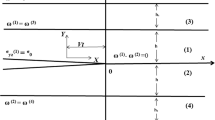Abstract
The antiplane shear deformation problem of two edge-bonded dissimilar isotropic wedges is considered. In the case when the sum of the two apex angles is equal to 2π, the problem reduces to that of two edge-bonded dissimilar materials with an interfacial crack subjected to concentrated antiplane shear tractions on the crack faces. An explicit expression is extracted for the stress intensity factor at the crack tip. In the special cases of different combinations of the apex angles, the obtained expression for the stress intensity factor may be simplified and relations of a simpler form are given for the stress intensity factor. It is shown that the stress intensity factor is dependent on the material properties as well as the geometry and loading. However, in special cases of equal apex angles as well as the case of similar materials the dependency of the stress intensity factor on the material properties disappears.
Similar content being viewed by others
References
Bogy, D.B.: Two edge-bonded elastic wedges of different materials and wedge angles under surface tractions. Trans ASME J Appl Mech 38, 377–386 (1971)
Chue, C.H., Liu, T.J.: Electro-elastic analysis of a bi-material piezo-electric wedge with an interface crack under antiplane concentrated forces and in-plane surface charges. Int J Solids Struct 41, 4179–4196 (2004)
Dempsey, J.P., Sinclair, G.B.: On the stress singularities in the plane elasticity of the composite wedge. J Elast 9, 373–391 (1979)
Dempsey, J.P., Sinclair, G.B.: On the stress behaviour at the vertex of a bi-material wedge. J Elast 11, 317–327 (1981)
Kargarnovin, M.H., Shahani, A.R., Fariborz, S.J.: Analysis of an isotropic finite wedge under antiplane deformation. Int J Solids Struct 34, 113–128 (1997)
Ma, C.C., Hour, B.L.: Analysis of dissimilar anisotropic wedges subjected to antiplane shear deformation. Int J Solids Struct 25, 1295–1309 (1989)
Shahani, A.R.: Analysis of an anisotropic finite wedge under antiplane deformation. J Elast 56, 17–32 (1999)
Shahani, A.R., Adibnazari, S.: Analysis of perfectly bonded wedges and bonded wedges with an interfacial crack under antiplane shear loading. Int J Solids Struct 37, 2639–2650 (2000)
Shahani, A.R.: A note on the paper ``Analysis of perfectly bonded wedges and bonded wedges with an interfacial crack under antiplane shear loading''. Int J Solids Struct 38, 5041–5043 (2001)
Ting, T.C.T.: Explicit solution and invariance of the singularities at an interface crack in anisotropic composites. Int J Solids Struct 22, 965–983 (1986)
Author information
Authors and Affiliations
Corresponding author
Rights and permissions
About this article
Cite this article
Shahani, A. Mode III stress intensity factors in an interfacial crack in dissimilar bonded materials. Arch Appl Mech 75, 405–411 (2006). https://doi.org/10.1007/s00419-005-0436-z
Received:
Accepted:
Published:
Issue Date:
DOI: https://doi.org/10.1007/s00419-005-0436-z




